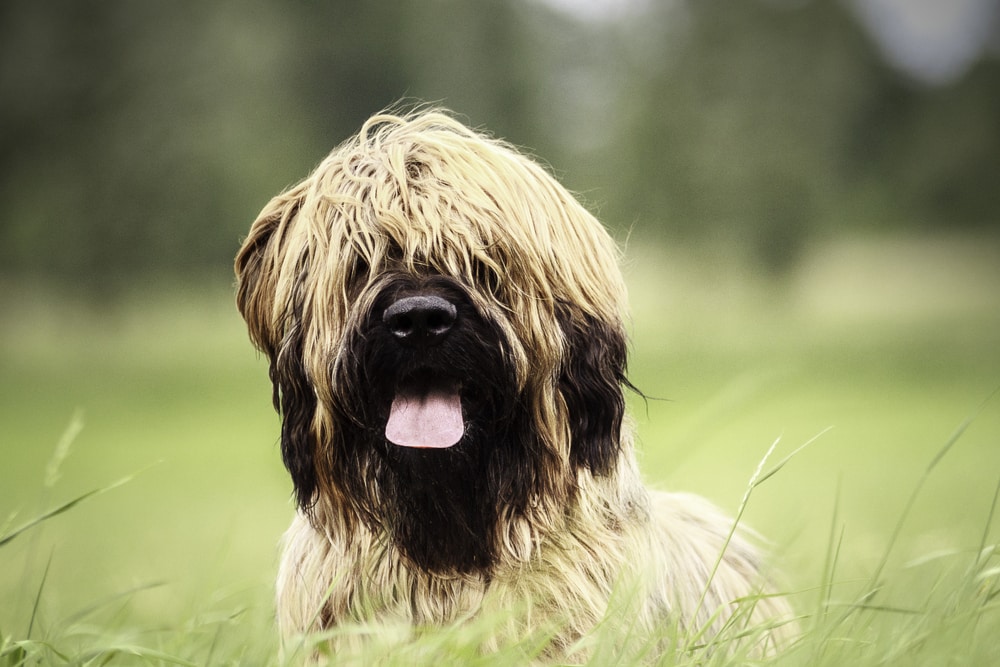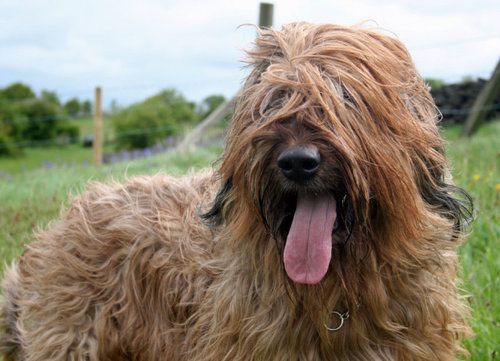Introduction
Pastoral and protective, the Briard has been working pastures since the 8th century. This ancient dog is not just a faithful guardian to its flock, it can also be a loyal family dog. Its multiple talents are not just handy for home or farm life, however. With the right training, this hardworking pooch can be an excellent messenger and search dog.
History
“Their extraordinary sagacity renders them extremely valuable, capable of being taught almost any duty that may be required of them, and the most anxious in the performance of that duty, the most watchful and faithful of all servants.” Such high praise from Thomas Jefferson himself for the Briard and many owners can attest to this sentiment.
But way before this breed won the hearts of many Americans, it served as a faithful herder and worked alongside farmers in the region of Brie. Also known as Chien Berger de Brie, the Briard wore several hats. During the time of Emperor Charlemagne, this dog was a popular guardian and herder. In the 1800s, it served a stint in the French Army as its official dog. Today, thanks to Thomas Jefferson and his friend, Marquis de LaFayette, the Briard have become faithful guardians and have been poking its humans affectionately to keep them in line.
Personality
Spirited, intelligent, athletic, and sensitive, the Briard is a gentle soul in a muscular body. Thus, it’s often aptly described as a “heart covered in fur”. Although it was originally bred to work on a farm as a herding dog, it evolved to step up to its purpose as part of a family. That’s why even if they love vast space and the things it can do in it, nothing comes close to spending time with its favorite humans.
But true to its guarding instinct, the Briard can be aloof with strangers. They can be notorious barkers; so when you have a visitor, a proper introduction is in order. Because of its intelligence, the Briard can have its own mind and be stubborn sometimes. That’s why obedience training should start early with this breed.
Appearance
You can easily identify a Briard by its shaggy and luxurious coat that comes in a variation of colors that include blue, black, grey, and tawny. Its double coat is made up of overly long and wavy outer coat, as well as fine and soft undercoat. Another distinctive features that mark this breed are its J-shaped tail and its double dewclaws in their rear legs, which helps them pivot easily when doing its herding duties.
The Briard has a height of 22-27 inches at the withers and they can weigh 55-100 lbs. Its head and ears are well-covered with abundant hair. They have large, calm, and well-set eyes that are hardly visible underneath those lush fur.
Health
Briards have a life expectancy of 10-12 years. Sadly, like all other dog breeds, they can be predisposed to a range of medical issues. As a responsible fur parent, you need to be on the lookout for symptoms of these illnesses.
Hip and Elbow Dysplasia
These conditions occur due to abnormal development of the bones, causing weakness and malformed hip and elbow joints. Common signs of hip and elbow dysplasia includes decreased activity, reluctance to move the legs, lameness, abnormal gait, and pain. When you notice these symptoms, you need to schedule an appointment with the vet right away.
In mild forms, hip and elbow dysplasia can be treated with medication and lifestyle changes. But if medication no longer has an effect on your pooch, replacement surgery is the only solution to relieve your fur baby of the pain.
Hypothyroidism
This condition occurs when your pooch’s thyroid glands no longer produce enough thyroxine, a hormone that controls metabolism and other body processes. Initial signs of hypothyroidism includes fur loss, dull coat, weight gain, muscle loss, slowed heart rate, and sluggishness.
The good news is, this illness is not life-threatening. The bad news is, this can affect your pup’s quality of life if left untreated. That’s why it’s imperative that you take your Briard to the vet right away when you notice these symptoms. The vet will likely prescribe oral medication to manage this illness.
Progressive Retinal Atrophy
Progressive retinal atrophy hereditary disease causes the image-forming part of the eye to deteriorate over time. This disease could eventually lead to blindness. If you notice your pooch having difficulty seeing at night or clumsily bumping into things, take it to the vet right away for proper diagnosis.
Von Willebrand’s Disease
This genetic disorder is characterized by a deficiency of a certain type of protein (von Willebrand factor protein) that’s associated with blood clotting. Due to lack of this protein, affected dogs are always at risk of severe bleeding. If you notice prolonged bleeding in your pup after an injury or trauma, take it to the vet for a check-up.
In emergency cases, a blood transfusion might be needed. And the vet would most likely prescribe medications to treat this disorder. In addition, you should closely monitor your fur baby if it’s taking other medications and make sure to accident-proof your house.
Congenital Stationary Night Blindness
This hereditary disease affects mostly Briards. Also known as hereditary retinal dystrophy, this condition affects the retina of your pooch’s eyes. Dogs with this disorder will have night blindness. Daylight vision can be affected in varying degrees. The bad news is, there’s no known treatment for this genetic disorder. The good news is, dogs with impaired night vision can still live a long and fulfilling life.
Gastric Torsion
Also referred as dog bloat or gastric dilation, gastric torsion is a disease wherein your pup’s stomach dilates and twists. This condition can be a result of varying situations like damage to the cardiovascular system, stomach distension, increased pressure in the abdomen, and lack of nutrients leading to tissue damage.
If you notice your Briard exhibiting symptoms like vomiting, excessive drooling, weak pulse, rapid heart beat, distended abdomen, and depression, consult the vet right away. This is an emergency situation that could potentially lead to death if not treated right away. Treatment depends on the underlying condition that caused this illness.
Cancer
If you notice any abnormal growth in your dog, don’t ignore it. Schedule an appointment to the vet right away. Some other signs of canine cancer that you must never disregard include sores that do not heal easily, bleeding, and abnormal discharges. Dog cancer, depending on the type, are usually treated with chemotherapy, medication, surgery, or a combination of these.
Tips for Taking Care of a Briard
This willing and protective caretaker also need protecting and care. As a fur parent, you have to keep in mind these considerations to give your pooch the quality of life it deserves.
Choosing a puppy
With the number of genetic disorders that a Briard is predisposed to, careful thought must be given in choosing a healthy puppy. Make sure that you only deal with responsible breeder with years of experience in breeding this type of dog. As per Briard Club of America’s guidelines, the parents of a litter must be tested for:
- Hip evaluation from the Orthopedic Foundation for Animals (OFA) or Ontario Veterinary Clinic (OVC).
- Eye examination from an ophthalmologist recognized by the American College of Veterinary Ophthalmologists (ACVO). Results must be registered at OFA and the Canine Eye Registry Foundation.
- Stationary Night Blindness test from OptiGen.
- Optional testing for autoimmune thyroiditis and elbow dysplasia from OFA or OVC.
In addition, it’s also a wise idea to check out the breeder’s facility and meet at least the mother dog. The living conditions of the dogs at the facility says a lot about the breeder and on top of that, you can also check the mother dog’s temperament. It’s very likely that your soon-to-be pup will take after its mother in terms of temperament so you must make sure it’s something you are happy with.
Nutrition
This athletic breed can consume 3-4 cups of high-quality dry dog food, which is divided and given twice a day. To ensure that your pup is in the best of health, make sure to give it the right amount of food. That means, you will have to adjust the amount depending on the level of its activity. If it spends most of its days indoors, lying on the couch, you have to give it less amount of food than when it spends its days herding flocks.
Grooming
Although Briards don’t shed much, their fur can easily get tangled and matted. To prevent this, you need to give it a daily brushing. Expect it to get dirty easily as well especially when it’s outdoors because its long fur can drag to the ground and accumulate dirt and debris. If you don’t have the time for the extensive grooming that a Briard requires, you will have to hire a professional to do it for you.
As with all other dog breeds, you need to regularly brush its teeth, trim its nails, and clean its ears. While you go about grooming your pooch, make sure to check it’s body for any signs of swelling, soreness, or abnormal growth. Should you notice any abnormality, check with the vet right away.
Training
Because of its keen intelligence, the Briard tends to be willful at times. But this is nothing that a good training won’t be able to smoothen out. To train this dog, you need to establish yourself as a firm and confident pack leader. Some dogs can be sensitive so make sure that even when you’re firm, you still deal with a light hand so as not to break its spirit.
Aside from the regular crate training, proper socialization, and obedience training, a Briard can be trained in other specialties. Some compete at agility or herding trials and they need the proper training for this.
Ideal Living Conditions
The Briard originated from a dairy farmland so it’s used to vast space as its playground. However, with the right training and a good amount of exercise, it can adapt to apartment living. Just expect to deal with one big fur ball of energy around the house. It can thrive well with kids and other animals. Although it wouldn’t be unusual to see it trying to poke them as it will first view kids and other animals as part of its “flock”. This behavior should be discouraged early on in its training.
With its supple gait and vigorous disposition, the Briard is everything you expect with a herding dog. But if you take the time to train it, this pooch could be so much more than a regular help in the farm. It can be an excellent family dog – complete with the alertness of a guardian and the goofiness of a furry friend.
Related Content




















